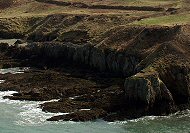
Rocky coast off Holyhead
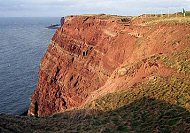
Rocky coast on Helgoland

Beach on the Ile d'Oléron
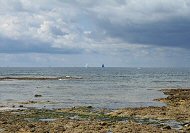
Tidal coast on the Ile d'Oléron
 Rocky coast off Holyhead |
 Rocky coast on Helgoland |
 Beach on the Ile d'Oléron |
 Tidal coast on the Ile d'Oléron |
Different as the form of different coastlines is, so are the gastropod species living there. Snail species of steep rocky coasts and surf zones look different from those of the calm Wadden Sea. There are also differences in the behaviour of coast-dwelling sea shells. Some of them tolerate falling dry temporarily, same crawl back into the water on the fist occasion, and finally others again will never leave the water.
Some groups of sea gastropods are described more elaborately on separate pages.
Limpets (Patellidae) are specialized inhabitants of the surf zone. Their strong foot enables them to cling to their rock even in the strongest surf. Limpets graze off algae growing on their rock and always return to their accustomed resting place. They defend themselves against offensive predatory whelks (Buccinum undatum) by clamping the attacker's foot under their shell.
![]() Elaborate description:
Limpets
(Patellidae).
Elaborate description:
Limpets
(Patellidae).
![]() Marine Gastropods: Ecology and Habitats: Patellogastropoda.
Marine Gastropods: Ecology and Habitats: Patellogastropoda.
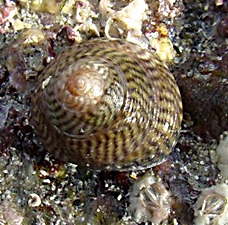
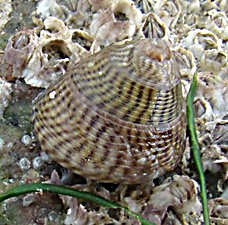 Grey top shell or Frisians' button (Gibbula cineraria). Picture: Florence Gully, Nature 22: Gastéropodes 2. |
Among the snails of the rocky coast there are also many top shells (Trochidae). On of these is the grey top shell (Gibbula cineraria), colloquially also referred to as Frisians' button. This species is found on the European coasts of the Atlantic and inhabits hard grounds continuously covered by water in depths up to 100 m (300 ft.).
The umbilicate top shell (Gibbula umbilicalis) inhabits a similar habitat. But on the other hand it is more tolerant to temporarily falling dry and to bracken water with a low salinity.
Gibbula umbilicalis is found in the Atlantic as well, for example in Brittany and on the western coasts of Ireland and Great Britain, but not in the North Sea.
![]() Paolo Pizzolla:
Gibbula
umbilicalis.
Paolo Pizzolla:
Gibbula
umbilicalis.
Top shells (Trochidae) are an ubiquitous family of small to large gastropods distributed worldwide in tropical, temperate and arctic waters. They possess some primordial characters - for example their heart has two atria and fertilisation takes place externally. Their horn-like shell-lid (operculum) closely fits the shell aperture.
The Trochidae are among the most frequent gastropod species of the Atlantic coasts. The largest part of them lives as algae grazers and detritus eaters, some species also feed by filtration.
![]() Economic Use of Sea Snails:
Top Shells (Trochidae).
Economic Use of Sea Snails:
Top Shells (Trochidae).
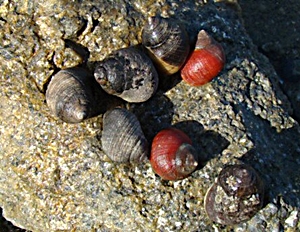 Common periwinkle (Littorina littorea). Picture: Florence Gully, Nature 22: Gastéropodes 2. |
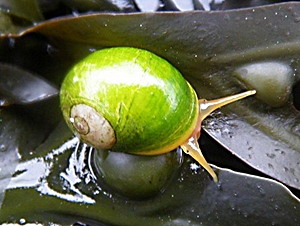 (Littorina obtusata) on bladderwrack (Fucus vesiculosus). Picture: Florence Gully, Nature 22: Gastéropodes 2. |
Periwinkles (Littorinidae) are gastropods adapted to the coastal zone, suited to temporary falling dry, as are the limpets. Apart from the common periwinkle (Littorina littorea) there are various smaller species living on the coasts of North and Baltic Sea in different depths: Littorina neritoides in the splash water zone, Littorina saxatilis in the high water zone and Littorina obtusata near the low tide line. Periwinkles are algae grazers, but they also feed on smaller invertebrates, such as barnacle larvae.
The common periwinkle is also edible and it is collected in large numbers, for example in Scotland (for about 7500 years). Today each year about 2000 tons of periwinkles are exported from there. Apart from the British Isles, periwinkles are also known as a delicacy in France (where they are called "bigorneau") and in Belgium, and they are also found in the African and Asian cuisine.
|
Periwinkles (Littorina spec.) at Rye Beach, New Hampshire, USA. Source, YouTube. |
An interesting fact is that many of the periwinkles' nearest relatives live on land, such as the terrestrial operculate snail (Pomatias elegans, also see Terrestrial Snails), which in Brittany goes quite far into the water as well. It may be assumed that one of the paths leading to the evolution of terrestrial snails, went by the ancestors of both periwinkles and terrestrial operculate snails.
In geology, the predecessor of the Baltic Sea is called Littorina Sea for the sake of fossil periwinkles that have been found.
![]() Wikipedia: Common
periwinkle..
Wikipedia: Common
periwinkle..![]() Marine Gastropods: Ecology and Habitats:
The Baltic Sea.
Marine Gastropods: Ecology and Habitats:
The Baltic Sea.
Periwinkles, however, are found not only on rocky shores, like the limpets do, but they are also found in the Wadden Sea. In Frisia they are called Tinkeltuut./p>
![]() Kari Köster-Lösche:
Europäische
Meeresschnecken.
Kari Köster-Lösche:
Europäische
Meeresschnecken.
![]() Köster-Lösche, K.; Lösche, K.-H.: "Tinkeltuut und
Co. Über Muscheln und Schnecken von Strand und Watt".
Köster-Lösche, K.; Lösche, K.-H.: "Tinkeltuut und
Co. Über Muscheln und Schnecken von Strand und Watt".
![]() Economic Use of Sea Snails:
Periwinkles (Littorinidae).
Economic Use of Sea Snails:
Periwinkles (Littorinidae).
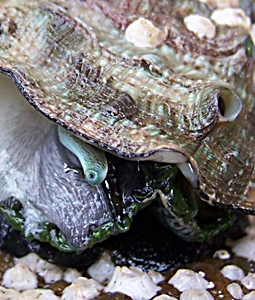 Green ormer (Haliotis tuberculata). Picture: Sylvie Danio, Nature 22: Gastéropodes 1. |
In spite of their mussel-like exterior, ormers (Haliotidae) are clearly recognizable as gastropods: A tiny spire of whorls almost disappears compared to the large apertural whorl. The small opening at the shell's rim are used to release the respiratory water transported into the pallial cavity through ciliar action.
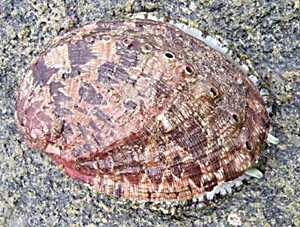 Green ormer (Haliotis tuberculata). Picture: Florence Gully, Nature 22: Gastéropodes 1. |
In Europe there is only the 9 cm (6 in.) long green ormer (Haliotis tuberculata), appearing in the English channel, where it grazes red algae off rocks of the channel islands.
A green ormer's shell surface is of a greenish colour, sometimes spotted. In contrary to that the inner side is covered by a distinct layer of nacre. The giant ormer Haliotis gigantea even produces pearls, as a mussel does.
Ormers, also known as abalones, have gained publicity in the
recent time, because in many places they are threatened or even
extinct, as they are collected as food, for example as "white abalone"
in South Africa. The musculous foot, which the snails use to cling to a
rock, is esteemed as a special delicacy. Most popular ormers
also are in Japan, where they are wrongly regarded as mussels
and are eaten raw as sashimi, called "Megai" (Haliotis
gigantea) or "Tokobushi" (Haliotis japonica).
![]() Wikipedia:
Seeohren.
Wikipedia:
Seeohren.
![]() Penny Avant:
Green
ormer (Haliotis tuberculata).
Penny Avant:
Green
ormer (Haliotis tuberculata).
![]() Tagesschau: "Auf
der Jagd nach den Abalones-Piraten".
Tagesschau: "Auf
der Jagd nach den Abalones-Piraten".
![]() Economic Use of Sea Snails:
Ormers and Abalones (Haliotidae).
Economic Use of Sea Snails:
Ormers and Abalones (Haliotidae).
In spectacular mating chains slipper limpets (Crepidula fornicata) can often be found. By the end if the 19th century the slipper limpet was introduced from America and because of the general warming increased fast in numbers.
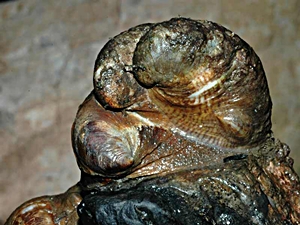 Slipper limpets (Crepidula fornicata) mating. Picture: Keith Hiscock, Marine Life Network. |
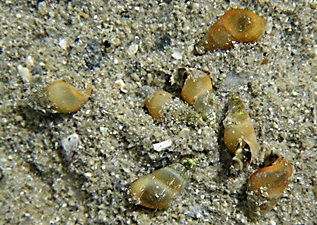 Laver spire shells (Hydrobia ulvae). Picture: Florence Gully, Nature 22: Gastéropodes 2. |
The laver spire shell (Hydrobia ulvae) is not only the smallest, but also the fastest snail in the Wadden Sea. Hydrobia ulvae will only grow to 3 to 6 mm and feeds on organic particles in the mud flats. By their faeces, they do their part in producing mud flats. With a mucus raft they float on the water surface and that way can cover distances of several kilometres. In the Baltic Sea, the laver spire shell can tolerate bracken water with a salinity as low as 10 per mill. On one square metre of mud flat sometimes up to 20,000 spire shell can be found! The scientific name Hydrobia ulvae, by the way, points towards the sea lettuce, Ulva lactuca, in which the snail often hides.
![]() Schutzstation Wattenmeer:
Die
Wattschnecke.
Schutzstation Wattenmeer:
Die
Wattschnecke.
![]() News.de:
Wo
die schnellste Schnecke der Welt lebt.
News.de:
Wo
die schnellste Schnecke der Welt lebt.
![]() Angus Jackson: Hydrobia ulvae.
Angus Jackson: Hydrobia ulvae.
![]() Marine Gastropods: Ecology and Habitats:
The Wadden Sea.
Marine Gastropods: Ecology and Habitats:
The Wadden Sea.
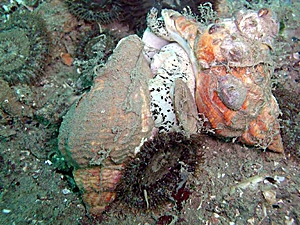 Whelks (Buccinum undatum) mating. Picture: Paul Newland, Marine Life Network. |
The common whelk (Buccinum undatum) is a predatory gastropod of the Wadden Sea feeding on carrion and on other molluscs, among others hunting in the oyster banks. On the other hand, whelks are esteemed by man to be a delicacy, but they are hard to come by, as they usually avoid to leave the water, other than periwinkles. Well known are the sturdy egg packets of the whelk, formerly used as sponges.
![]() Common
whelk
(Buccinum undatum): Biology and Ecology.
Common
whelk
(Buccinum undatum): Biology and Ecology.
![]() Economic Use of Sea Snails:
Whelks (Buccinidae).
Economic Use of Sea Snails:
Whelks (Buccinidae).
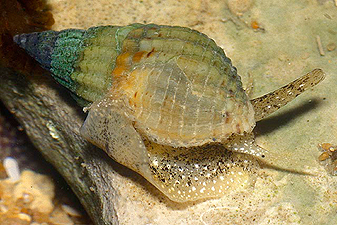 Netted dog whelk (Hinia reticulata). Picture: Eric Walravens. |
The netted dog whelk (Hinia reticulata), another predatory gastropod of the coast, also feeds on carrion. Near the beach it can often bee seen in numbers feeding on a dead animal.
In contrary to the common whelk, the netted dog whelk, which is much smaller (only up to 3 cm shell length) stays in deeper water and alive never gets to the shore. A netted dog whelk's siphon is characteristically long, and olfactory sense cells provide the snail with information on its prey.
The netted dog whelk is among the snails that need a certain grade of salinity, which is why they are only found in special spaces, where salt water from the North Sea in prevails.
The shell surface of netted dog whelks is full of crossing ribs making the characteristic net pattern. The shells often are populated by symbiotic hydrozoans (polyps), Podocoryne carnea.
Porcelain shells (Cypraeidae) (the term cowry shells is better known) are a large, mainly tropical, family of sea snails, among which there are some spectacular species, whose beautiful shells shimmering in all colours of the rainbow enchant collectors, trades and scientists alike.
Compared to their tropical relatives, the European cowries are tiny and much less conspicuous. But from the Mediterranean, along the Atlantic coast up to Brittany and the Irish and British west coasts the shells, about 12 mm long, of Trivia monacha can be found, because of the three conspicuous brown spots also called the coffee bean shell.
Systematically, Trivia monacha belongs to an own family, the Triviidae, which are only related to porcelain shells, but which strongly resemble to them. That is why Trivia monacha in English also is called "European cowry" or "spotted cowry".
![]() Cowry Shells (Cypraeidae).
Cowry Shells (Cypraeidae).
![]() False Cowry Shells (Triviidae).
False Cowry Shells (Triviidae).
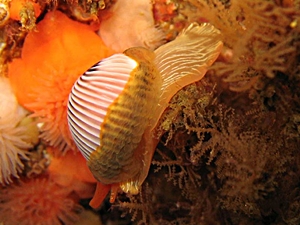 European cowry (Trivia monacha) in its usual ha- bitat. Picture: Robert Keen, Marine Life Network. |
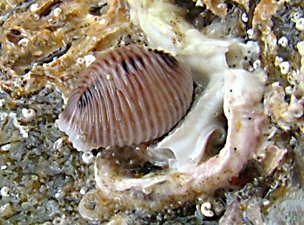 European cowry (Trivia monacha) at the coast. Picture: Florence Gully, Nature 22: Gastéropodes 1. |
Porcelain shells, and so is Trivia monacha, are recognizable by a special kind of shell, whose apertural whorl overgrows all other whorls and so hides the shell's spire, by which it would be recognizable as a snail shell. In an x-ray picture, though, all whorls are clearly visible inside the shell. The juveniles, up to a size of 5 mm, still have the typically coiled shell; their aperture is wide, not longitudinal and slit-like, as in adult shells.
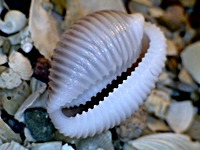 Shell ofTrivia monacha. Picture: Holly Latham, Marine Life Network. |
The shell surface of the coffee-bean shell is covered with distinct ribs which are whitish and set off from the remaining shell. The snail does not possess a shell-lid (operculum). Like in the large porcelain shells, the live animal's mantle covers a large portion of the shell. In Trivia monacha, the living body, in contrary to the pale reddish shell surface is brightly coloured in yellow, orange or red.
Trivia monacha is a small carnivore living at the lower coast and the so-called sublittoral zone among colonies of ascidian Tunicata it feeds on. After mating season in late spring and summer, the female place bottle-shaped egg capsules inside the empty tunicates. From those, veliger larvae hatch, which disperse through the open water for some months.
A near relative, with which Trivia monacha is likely to be confounded, is the Northern cowry, Trivia arctica, which is smaller and also lacks the coffee spots. Trivia arctica in principle shares the distribution area of Trivia monacha, but is found farther to the North and is also more frequent in the North.
![]() Sonia Rowley:
Trivia monacha.
Sonia Rowley:
Trivia monacha.
![]() Wikipedia: European cowry.
Wikipedia: European cowry.
![]() Wikipedia: Trivia arctica.
Wikipedia: Trivia arctica.